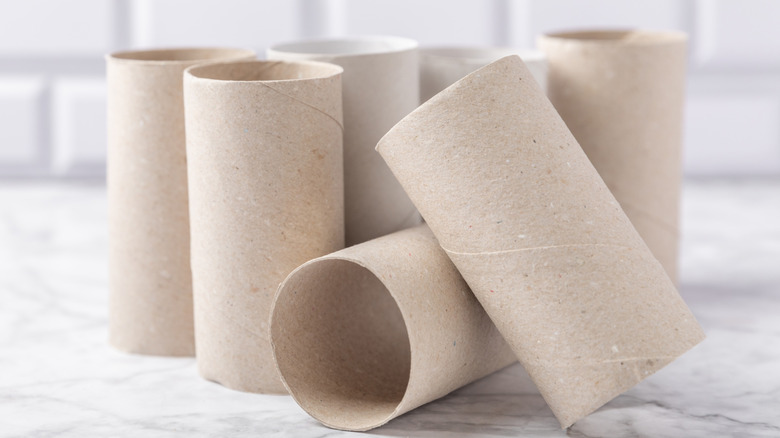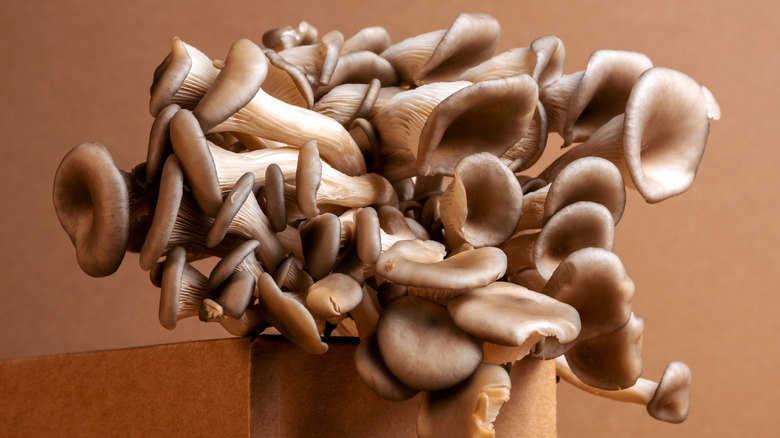Grab An Empty Toilet Paper Roll And Watch What Culinary Gem You Can Grow
We may receive a commission on purchases made from links.
Growing tons of tasty mushrooms at home is simpler than you might expect. Take, for example, oyster mushrooms, which boast a meaty texture and mild flavor that's somewhat reminiscent of seafood or anise. They will grow on newspapers, straw, and many other materials you probably have in your house or garden. Various cardboard objects will also do the trick. Empty toilet paper rolls are a good choice because you don't have to remove extraneous materials such as glue or tape.
Different methods exist for cultivating oyster mushrooms on cardboard, which is called substrate in the container gardening world. Most approaches involve water, a container such as a sealable plastic bag or a 5-gallon bucket with a lid, and pieces of a mature oyster mushroom. If you don't have a mushroom handy, order a product called oyster mushroom spawn. Liquid Fungi blue oyster mushroom grain spawn is a solid choice since blue oyster mushrooms are especially easy to cultivate.
Your first task is getting your cardboard tubes ready. If you plan to cultivate mushrooms in a large container, consider flattening your toilet paper rolls so lots will fit inside. If you use a bag, tear the rolls into small pieces. Afterward, pasteurize the cardboard. To do this, place each piece in a pot of boiling water for a minute or so. Soaking them for longer can make them waterlogged, which doesn't support mushroom growth. Let the pasteurized cardboard cool on a sterilized surface, but don't let it dry out. Use isopropyl alcohol to sterilize the inside of your container, too. Then it's time to set up your mushroom-growing habitat.
How to cultivate oyster mushrooms on leftover cardboard
To grow your oyster mushrooms in a 5-gallon bucket, start by adding holes to its sides. They help aerate the environment inside the bucket and act as doors for light-seeking mushrooms to crawl through. Next, place a layer of cardboard on the bottom of the bucket. Cover this layer with mushroom spawn or pieces. Repeat this process, adding layers of cardboard and mushroom until about ⅔ of the bucket has been filled. As you do this, compress each layer to help the mushroom matter stick to the cardboard. Then, cover the bucket and put it somewhere dark and slightly warm, between 60 and 75 degrees Fahrenheit if possible. Harvest-ready mushrooms will pop through the holes in a month or two.
Using a plastic bag instead? Make sure it can hold at least a gallon of material, then add equal amounts of damp cardboard and mushroom matter, stirring them together every now and then. Next, close the top of the bag, fashioning a small opening to aid air circulation. Put ventilation holes in the sides of the bag, too. Then, place the bag in a warm, dark place. Check it periodically and mist its contents with water if they look dry. Your mushrooms will be ready to pick in three to six weeks. To try another mushroom gardening method, use toilet paper that's still on the roll. Instead of filling a plastic bag with cardboard pieces, insert paper-covered rolls you've briefly dipped in hot water. Sprinkle mushroom matter on the toilet paper, leave an air hole when closing the bag, and enjoy fresh oyster mushrooms in a few weeks.

